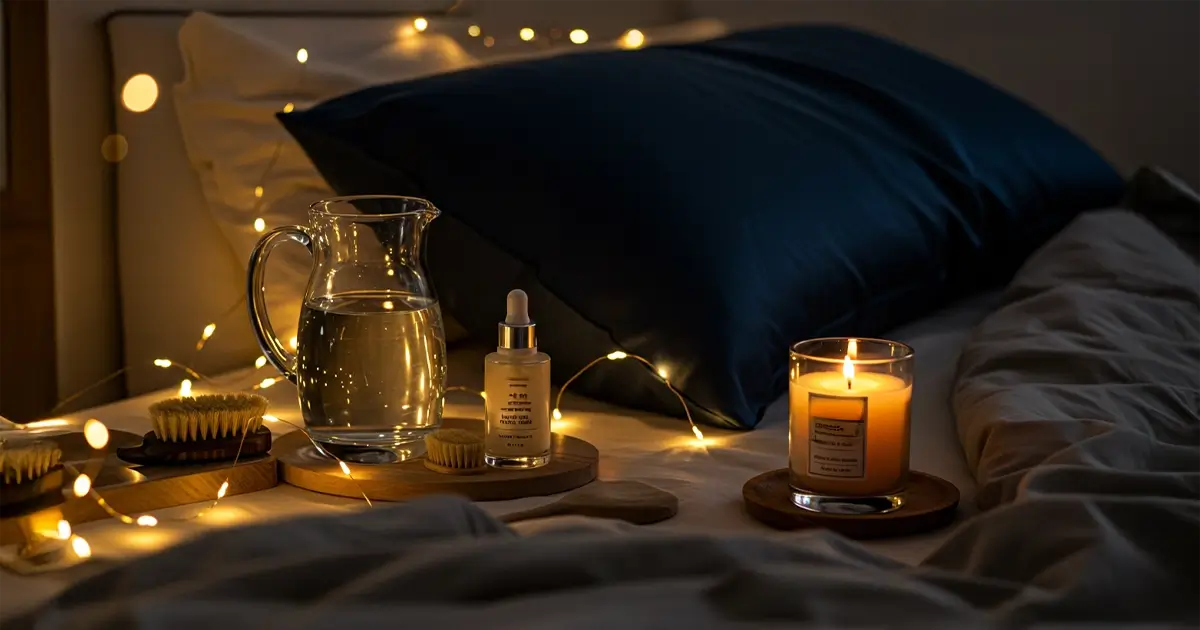Tonight we are diving into the blissful science and simple pleasures of a thoughtful night skincare routine, so you wake up with a happy-looking mirror greeting. We will unpack proven evening skincare steps, key barrier-loving ingredients, and pillow-friendly lifestyle tweaks in one smooth, 9 minute read.
Why Night Is the Prime Repair Shift
I like to think of bedtime as my skin's team meeting, because when the lights go out, repair enzymes clock in. Circadian studies from Harvard Health show that cell turnover peaks around 2 am, meaning anything we apply beforehand gets VIP access to deeper layers.
Melatonin levels also rise after dusk. This hormone is a champion antioxidant, mopping up the free radicals collected during the day, while the stratum corneum loosens just slightly, letting well-chosen actives soak in instead of sitting on top.
Finally, blood flow to facial skin increases during rapid-eye-movement sleep, boosting nutrient delivery. If you have ever noticed that dull tone after a late-night Netflix binge, poor micro-circulation is the culprit, not an instant episode of aging.
Cleanse Like a Pro Before You Hit the Pillow
The clean canvas rule is non-negotiable, so I start with a micellar water sweep to lift sunscreen and mascara, then follow with a gentle gel cleanser. Dermatologists at the American Academy of Dermatology stress fingertips over washcloths because friction equals irritation, especially when you are half-asleep and heavy-handed.
Double cleanse roadmap:
- Micellar or oil balm for makeup and SPF break-up.
- Water-based, low-foam cleanser to whisk away residue.
- Lukewarm rinse, never hot, and soft-pat dry, because tugging stretches collagen.
If you wear long-wear foundation or city pollution feels visible, add a 60-second massage with cleanser two to three times a week. That tiny pause invites lymphatic flow, plus it feels like a pocket spa moment before bed.
Serum, Cream, Occlusive: Layering for Maximum Effect
Choose Your Active Serum
Night is perfect for molecules that need uninterrupted hours. Prescription or over-the-counter retinoids top my list. According to the Mayo Clinic's tretinoin guidelines (reference), starting three nights a week and building tolerance prevents the dreaded flake-fest. Alternate evenings can feature peptides or niacinamide for redness-prone friends.
Seal with a Barrier-Loving Cream
After serum, I reach for a mid-weight moisturizer rich in ceramides. Think of it as mortar between skin cells, keeping transepidermal water loss low. If you missed my earlier deep dive, hop over to my Ceramides 101 guide for the nerdy details.
Lock It In Gently
On winter nights or when indoor heating is relentless, I dot a thin layer of petrolatum along my cheekbones and lips. Occlusives trap water, not oil, so they are surprisingly breakout-friendly if used sparingly. Remember, a pea size is plenty.
Beyond Skincare: Lifestyle Tweaks That Amplify Results
Product layers matter, yet a few bedroom habits act like invisible serums. First up: sleep duration. Seven to nine hours gives keratinocytes enough runway to complete mitosis cycles. Less than six, and repair pauses halfway, like leaving laundry mid-spin.
Next, invest in a silk or sateen pillowcase. Minimized friction reduces overnight creases and limits product absorption by fabric. I joke that my pillow now looks smoother than some phone screens, but the difference on my cheek lines is clear.
Finally, keep humidity above 40 percent with a bedside diffuser. Adequate ambient moisture slows water evaporation from skin, meaning your pricey night cream works smarter, not harder.
FAQ
Can I use retinoid and vitamin C together at night?
I prefer vitamin C in the morning for antioxidant backup against UV. Using both at once can raise irritation risk, so alternating day and night keeps skin calm.
Do I really need a separate eye cream?
If your regular moisturizer is fragrance-free and light, you can tap it around the orbital bone. Dedicated eye formulas add perks like caffeine for puffiness, but they are optional, not mandatory.
How long should I wait between layers?
About one minute, or until the previous product feels touch-dry. This prevents active dilution without turning your routine into a marathon.
Is a toner essential in the evening?
Only if it adds value, such as gentle polyhydroxy acids or calming panthenol. Alcohol-heavy toners strip lipids and undo your cleanser's gentle work.
Why does my skin tingle after retinol even months later?
Seasonal changes, exfoliation frequency, or a new formula strength can reset sensitivity. Dial back to every other night, and add a simple barrier cream until calm returns.
Conclusion
Nailing your night ritual comes down to three pillars: effective cleansing, purposeful layering, and supportive sleep habits. When these pieces click, the morning mirror shows smoother texture, even tone, and that confident rested look we all crave.
I would love to hear your bedtime skincare wins and woes in the comments. See you in the next post - until then, take good care of your skin!


Comments (0)
No comments yet - be the first to share your thoughts!
Leave a Reply
Your email address will not be published. Required fields are marked *